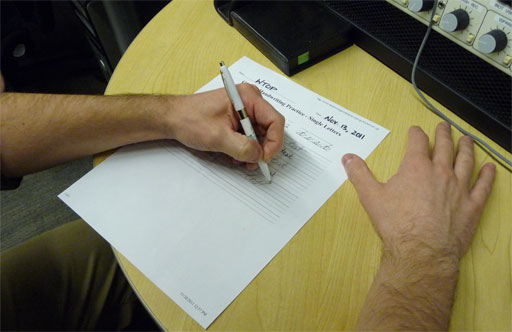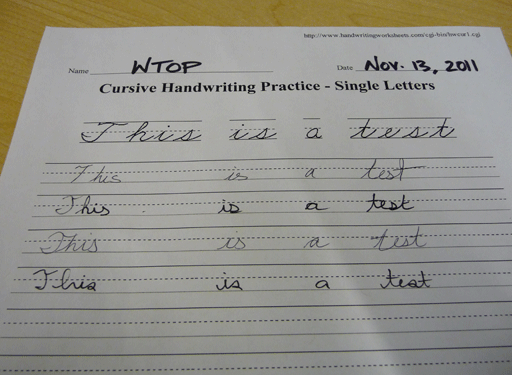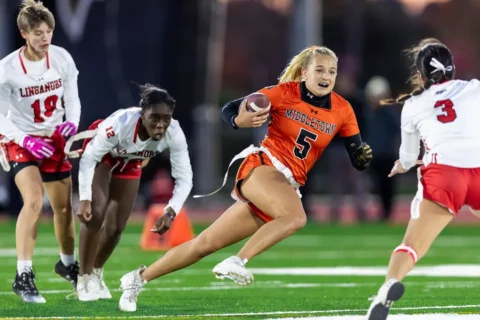



Meera Pal, wtop.com
WASHINGTON – On a daily basis, most adults are probably not picking up a pen to write something down. If they do, the chances they are writing in cursive are slim to none.
“I don’t really write cursive,” says Kelly Mercado, a nurse from Germantown, Md. “I use a mixture of print and cursive when I write.”
Mercado was surprised when her third-grade daughter, Meghan, came home one day writing her name in cursive.
“She must be learning it in class,” she says.
Teaching cursive in the classroom is part of a larger national debate.
“Cursive is not included in the so-called common core standards, which will govern teaching and lesson plans in 46 states,” The Baltimore Sun reports.
Maryland and D.C. have adopted the Common Core State Standards, while Virginia has not.
“There’s not much debate here at the department. We think it’s important. It’s something we continue to emphasize,” says Bill Reinhard, spokesman for the Maryland State Department of Education. “At the same time, it is not something that our systems have to follow. Systems do have some flexibility.”
“Most Maryland schools continue to hold it at high regard,” he says.
Cursive is taught in third grade in all Montgomery County Public Schools, says Betsy Brown, director of the department of curriculum and instruction.
But given that Maryland had adopted the Common Core State Standards, the school system is entering a period of transition, she says.
“It is possible it will not be a strong requirement nationally. We’re trying to figure that out as a system and a country,” Brown says.
“There is a clear signal that we need to look at what our students truly need to learn in order to make it in a very tech-heavy and media-heavy environment. The world is changing faster than even we can describe it,” Brown says.
“We need to prepare our students as best we can for all of the skills that they’re going to be asked to use.”
Mercado says she sees cursive going by the wayside, with computers taking over as a tool for writing. As a nurse, she has seen doctors’ chart-writing go electronic, which she says is not entirely a bad idea.
“One doctor usually handwrites his charts and it’s a mixture of cursive and some print. It gets to a point where I don’t understand some of what he’s writing,” she says.
Her own handwriting has deteriorated, as well, Mercado says.
“Even my signature; It’s kind of a scribble. It’s a ‘k’, a couple of ‘l’s’ and a squiggle,” she says.
Pat Fege, the language arts coordinator for Fairfax County Public Schools, says if you don’t use it a lot, it tends to degenerate.
In line with Virginia state standards, Fairfax County does teach cursive beginning in second grade.
“Cursive is very much a part of the instructional program of the elementary grades in Virginia,” says Charles Pyle, director of communications for the Virginia Department of Education.
“Students are supposed to be able to write legibly by third grade.”
Pyle says that despite the debate on the importance of cursive and the impact technology is having on the handwriting, in general, Virginia recognizes cursive to be important and will continue to teach it to students.
“There will be a time and setting when technology isn’t available and young men and women will still need to be able to communicate in an effective and clear manner and that means cursive,” he says.
Reinhard says his wife, who is a teacher in Maryland, makes sure all of her students can sign their names to their work, in cursive.
“It’s something that should be preserved in our society. You have to sign documents and letters,” he says.
Fege says handwriting used to be considered a mandatory life skill.
“It used to be a very utilitarian thing. Women and men had to learn to use it because it was a life skill,” she says.
But until everything is completely transformed into digital format and everyone is using tablets or smartphones, Fege says handwriting will still be a necessity.
In D.C. public schools, spokesman Fred Lewis says cursive was in the district’s previous core standards, with students required to write legibly in cursive by third grade.
Now that D.C. schools have adopted the Common Core State Standards, there is no longer a requirement to teach cursive.
“Individual DCPS schools may include the teaching of cursive in their curriculum and instruction,” Lewis writes in an email.
Pyle says handwriting and technology are not mutually exclusive and students should be well-versed in both skills.
“Until we’ve completely changed to digital, kids need to learn how to read and write cursive,” Fege says.
Admittedly, many adults today have a hard time writing cursive. In the WTOP newsroom, we conducted our own cursive test, asking staffers to handwrite the same sentence.
One staffer said as she was writing, “My hand hurts.”
Reinhard says while he uses cursive almost every day, “I have lousy handwriting. I got a ‘D’ in handwriting in elementary school. I’m not sure anyone beyond me can read it.”
How is your cursive handwriting? Let us know on Facebook or on Twitter using #WTOPcursive
Follow WTOP on Twitter.
(Copyright 2011 by WTOP. All Rights Reserved.)







